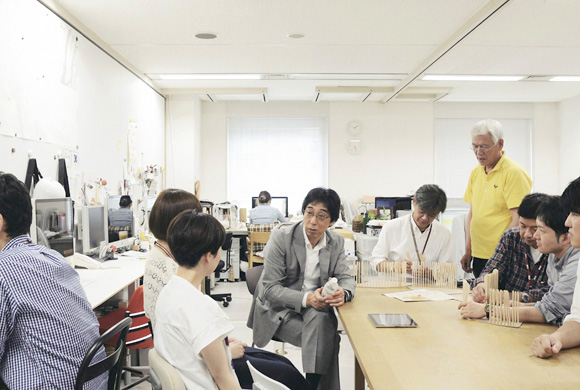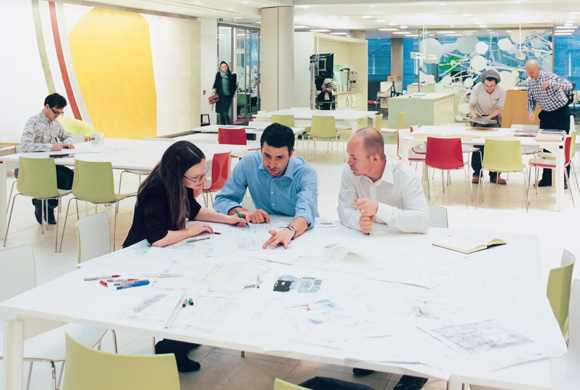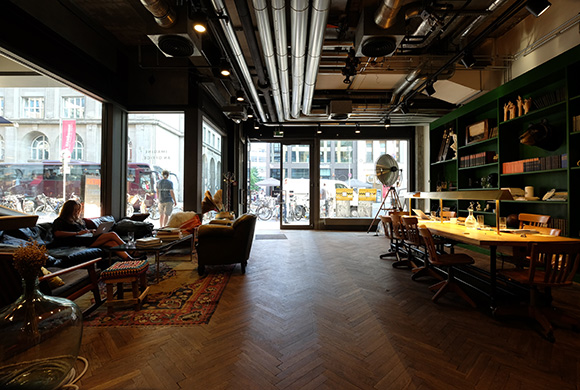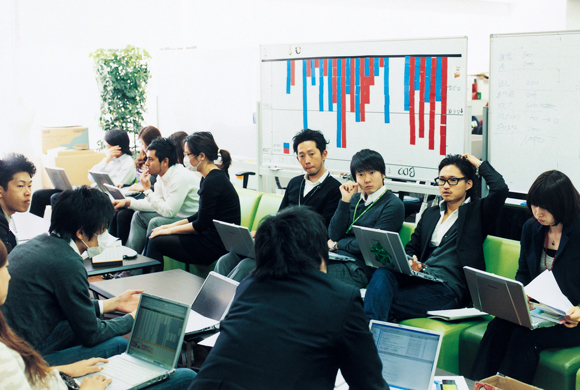Workplace
Feb. 4, 2013

An Office to Redefine The Corporate Philosophy
The operating company behind famous Japanese retailer Mujirushi Ryohin
[Ryohin Keikaku] Toshimaku, Tokyo, Japan
Mujirushi Ryohin (literally “no-brand quality products”) began as a private label of the Seiyu department store in 1980. The concept was “Lower priced for a reason” something that gained wide acceptance as the brand grew beyond the framework of Seiyu alone. In 1989, Ryohin Keikaku, was established. Today it is a brand with 535 shops across Japan and abroad, selling some 7,500 individual items.
In the 30 years that followed from the founding, that corporate philosophy and the products themselves did not get old, and the number of fans remained steady, regardless of age, gender or country. However, it wasn’t all smooth sailing.
After being independent, the offer came to join the Saison Group as a subsidiary company, and the path was chosen for expansion and the creation of large-scale stores. However, this also led to the mass production of inferior goods. Faith in the brand began to crumble, and management had a painful role to play in 2000. Stores were closed, wage reorganization began, and, in this period of restructuring, the company also began a review of the corporate culture itself.The decision was to regain the original, pure corporate philosophy, and to refocus on marketing based on real customer needs. It was an urgent task.
The failure of the profit-driven path taken in the 1990s revealed a problem that had not been previously seen. “In some ways there was the desire for Mujirushi Ryohin to be a kind of utopia, but many employees did not have the expertise to handle furniture, clothing and tableware, and there was no planning or sales strength applied,” says President Masaaki Kanai in retrospect.
The decision was made that a short-term drop in sales would be all right, but that the company had to begin creating the products that customers would notice, so in 2007 the “Naruhodo (that’s right!) Mujirushi Ryohin” campaign began. This was also where creative hit products such as a “branded umbrella” and “not itchly turtleneck” were born. The company had returned to its original idea, they were paying careful attention to customer needs, and employees began to feel that if they created something they thought was good, it in turn would sell.
 Founded 1980 (as a private brand of Seiyu)
Founded 1980 (as a private brand of Seiyu)
Sales (as of February 2012): ¥150.9 billion
Employees (as of February 2012): 5,197
(including part-time)
 Masaaki Kanai
Masaaki Kanai
President, Ryohin Keikaku
Joined Seiyu Store in Nagano in 1976. Transferred to Ryohin Keikaku in 1993; as lifestyle goods manager he was in charge of product development. Served as General Manager of the Sales Division, Managing Director and Director of Sales, and Senior Managing Director before taking his current position in 2008.
It was at that time that Mr. Kanai began to visit stores around the country. Each time speaking to about 30 people, and after a few days a total of 1,500, he explained the origins of Mujirushi Ryohin, and what the company was aiming at. In the evenings he would hold meetings with the regional store managers. “When I talked to them, I didn’t think it would be good to talk about the ‘real’ things such as sales or profits,” he says. “Cost consciousness is important, but I wanted instead to say straight to them that this is how we should think about Mujirushi Ryohin.”
After taking the nationwide tour, the next time the travels would be the job of company executives. By the president and executives going out to meet employees with no hidden agenda and building a feeling of trust, the thought was that gradually the store employees would think, “Well, this is the right way of doing things,” and that they could themselves begin to think of plans to accomplish it. By entrusting more and more to motivated employees, action began to occur.
Previously, product planning and sales were completely different career paths, but now it was seen that a person capable in sales could well be superior in planning. As much as possible, part-time workers who wished to become full employees were also given employment. At the same time, a local employee organization was created for Mujirushi Ryohin employees whose lives were more tightly connected to the local area.
 Next to the planning and design room is the workshop, where mockups and prototype models are created.
Next to the planning and design room is the workshop, where mockups and prototype models are created.
 The reference room of the office. A huge number of previous prototypes documents and other materials can be found here.
The reference room of the office. A huge number of previous prototypes documents and other materials can be found here.

There was one more area of review: the corporate culture. “We were originally a business within a department store,” Mr. Kanai says, “so there were some strong words still in the company, such as ‘diligent management’ and ‘discipline.’ There was a gap between the modern image projected to the outside by Mujirushi Ryohin and the unchanged feeling of Ryohin Keikaku, something that was rather startling for new college graduates when they began their careers here.”
The chairs and desks used by the employees had the feeling of an old-time Japanese corporation. As this slowly began to change, there was much more stronger feeling among the employees that they wanted to improve their own office. “At the beginning it was about clearing up the rubbish around themselves—it was that obvious at first,” Mr. Kanai says. “Later people realized that someone had added flowers for decoration, to make the office more like their ideal.”
From WORKSIGHT 02(Jun.2012)
Meeting rooms feature panels with the company’s philosophy.
 Displayed on the wall beside the desk are hit products. The materials threaten to overflow the space.
Displayed on the wall beside the desk are hit products. The materials threaten to overflow the space.









